Affiliate disclosure: This post may contain affiliate links. Please see our Privacy Policy.
Seedless blackberry jelly is easy to make at home, and all you need is blackberries and sugar (no added pectin required).
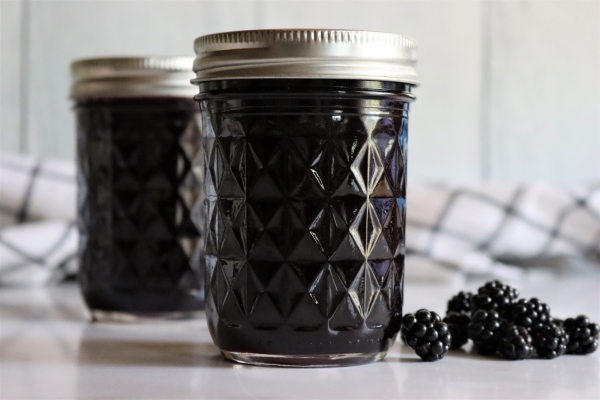
Blackberries are my husband’s absolute favorite fruits, and he absolutely loves my homemade blackberry jam (seeds and all).
My kids though? They’re all about jellies.
Smooth, spreadable crystal clear jellies that jiggle a bit on top of a piece of toast, or effortlessly stir into a bowl of plain yogurt.
Take the kids out blackberry picking, and they’re going to expect homemade blackberry jelly before the day is out.
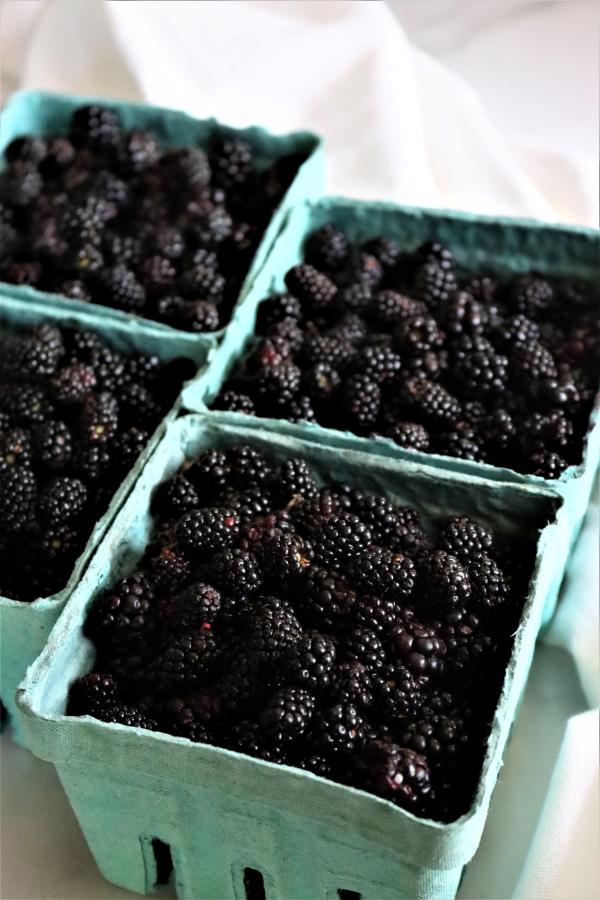
Blackberry jam or jelly, it doesn’t really matter. The recipe is remarkably similar and comes together with just two ingredients and no added pectin.
Wild or commercially grown, blackberries have plenty of natural pectins. Even when the seeds and skins are strained out, it’ll still come together into a smooth dark jelly in minutes once you add sugar.
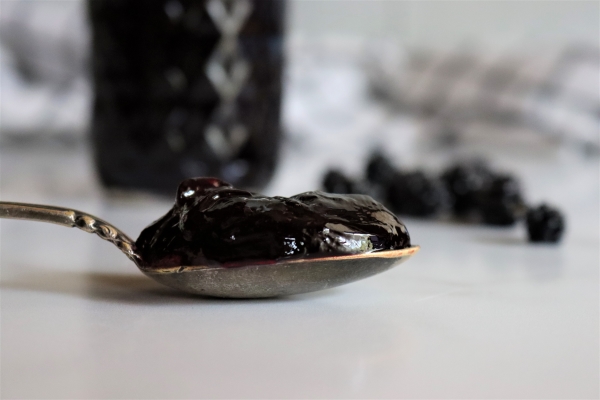
Making Blackberry Jelly without Pectin
Homemade blackberry jelly starts by extracting blackberry juice.
A “batch” of jelly is usually made from 4 cups of juice, and for that, you’ll need to start with about 9 cups or 2 1/2 quarts of berries. Add in a cup of water (so they don’t burn), and bring the berries to a boil over medium-high heat.
Mash the mixture as it cooks, and after about 5 minutes the berries should have completely fallen apart.

Pour the blackberry pulp through a jelly bag (or a piece of dampened cheesecloth lining a strainer), and allow the mixture to drain for several hours.
Resist the temptation to squeeze the jelly bag, as most people say that’ll make your finished blackberry jelly cloudy. (Personally, I usually squeeze the bag, and my jellies still come out crystal clear, so I’m skeptical.)
While many people suggest letting it drip overnight, I’ve found that an hour is more than enough time for just one batch of juice. (If you’re making a huge batch, it might require a good bit more time to fully drain.)
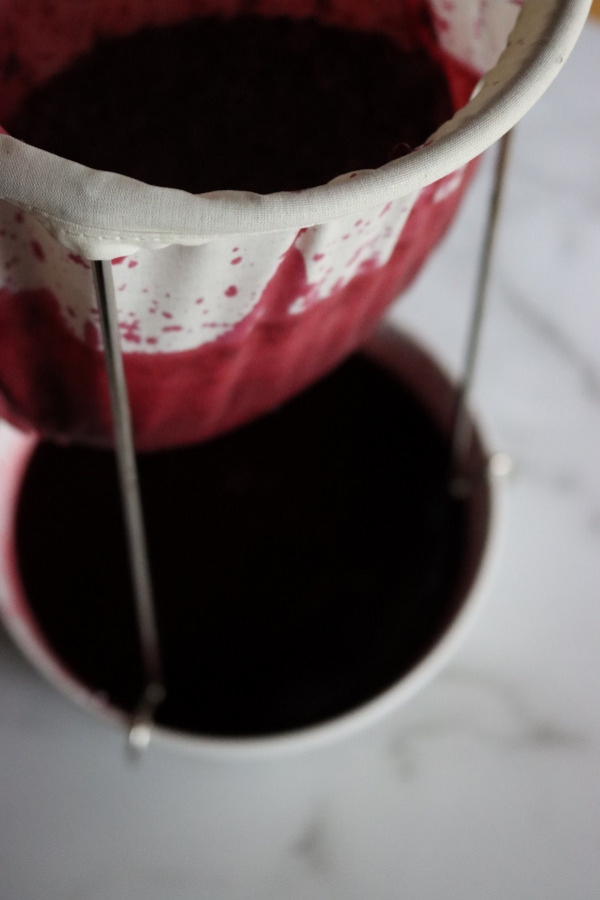
Measure the strained juice. Ideally, at this point, you’d have 4 cups of juice, which makes the math and yields simple. But really, it doesn’t much matter.
For every cup of blackberry juice, add 3/4 cup of sugar.
If you did end up with 4 cups (as I did), then add 3 cups of sugar.
Bring the juice/sugar mixture to a boil over high heat, stirring frequently to prevent scorching.
Be sure to use a deep-sided pot, as the jelly is going to foam up considerably before it’s done. I’d suggest starting with the pot no more than 1/3 to 1/2 full.

The mixture should reach gel stage after about 8-10 minutes of cooking.
You can test for gel stage by spooning a bit onto a plate that’s been placed in the freezer. It should flash cool the jelly and show you the finished texture.
I find an instant-read thermometer is a more reliable measure. Gel stage happens at 220 degrees F at sea level, and a bit below that at higher elevations. Subtract 1 degree for every 500 feet above sea level to find gel stage at your location.
For example, I’m at 1000 feet elevation, so I finish my jellies at 218 F.
Either way, once the blackberry jelly reaches gel stage, ladle it into prepared jelly jars. Starting with 4 cups of blackberry juice and 3 cups sugar, this recipe should yield about 4 half-pints (8 oz) jars.
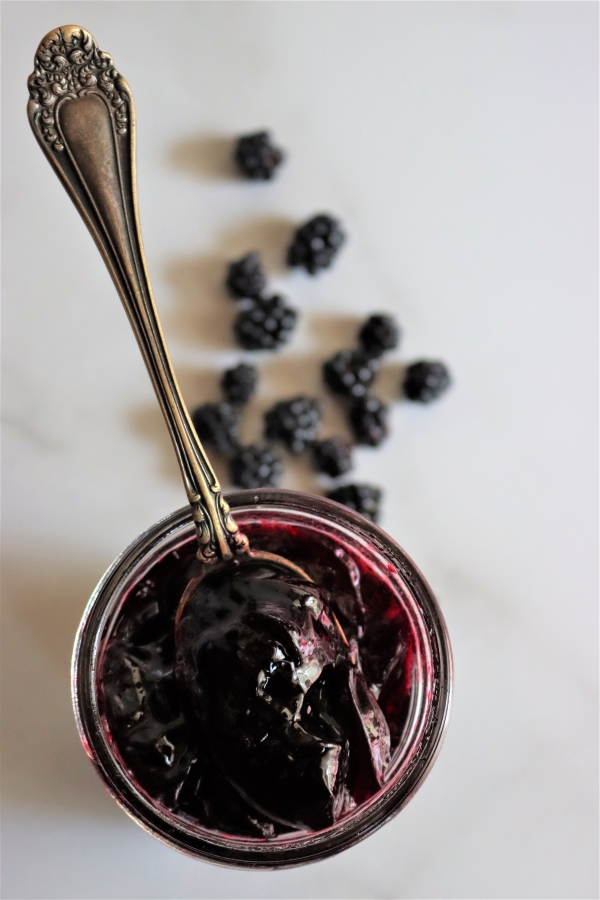
Blackberry Jelly with Pectin
I don’t suggest adding commercial pectin to blackberry jelly, because it’s completely unnecessary.
That said, if you really feel the need to add pectin to blackberry jelly, you can, but it won’t actually change much. The pectin needs a certain amount of sugar to gel properly, so you’ll need to add at least 4 -5 cups of sugar (for 4 cups juice), and then you add in the box of pectin.
It cooks for a similar amount of time, and you’ve added more volume (in sugar and pectin), to get 5 half-pint jars instead of 4.
The pectin isn’t changing anything here, just adding expense (about $5-6 a box) and calling for more sugar (when it’s really not needed). Naturally gelled jellies actually have a nicer texture anyway, that spreads smoother.
I only add boxed pectin when I absolutely have to, like when I’m working with very low and no pectin jellies. Things like cherry jelly, where the fruit has almost no pectin, or floral jellies like dandelion jelly where it’s not even fruit (thus no natural pectin).
Still, if you’re set on popping a box of sure jell in there “just in case,” then here’s the recipe for blackberry jelly with added pectin:
4 cups blackberry juice (from 9 cups fruit)
4 1/2 cups sugar
1 box Sure-Jell Pectin (1.75 oz)
Add the pectin to the juice (but not the sugar), and bring it to a boil on the stove. Once it’s boiling hard, add the sugar. Boil hard for 1-2 minutes, then pour into prepared jars leaving 1/4 inch headspace. Yield should be right around 5 half-pint (8 oz) jars.
This is not the method I recommend. I’d suggest skipping the pectin and using 3 cups of sugar (rather than 4 1/2), to make a simple no pectin added blackberry jelly.
I promise it’ll set beautifully…
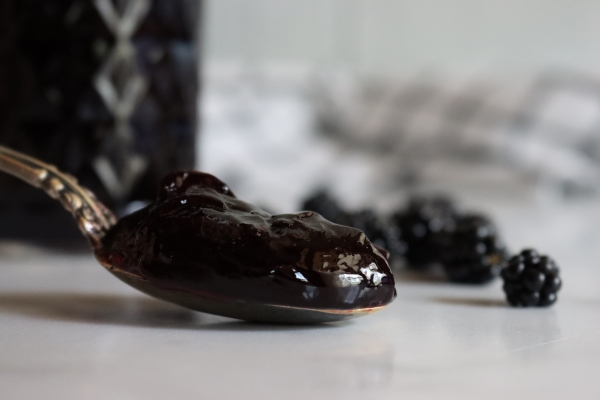
Canning Blackberry Jelly
While you can just store this homemade jelly in the refrigerator for up to 2 weeks, or freezer for up to 6 months, I generally prefer to can my homemade preserves.
Canning is optional, but it’ll allow you to enjoy homemade blackberry jelly year-round, as canned goods retain peak quality at room temperature for 12-18 months.
To can blackberry jelly, prepare a water bath canner while the juice is straining.
Once the jelly reaches gel stage, ladle it into prepared canning jars leaving 1/4 inch headspace.
Process in a water bath canner for 10 minutes.
Remove the jars to cool on a towel on the counter. After 24 hours, check seals and store any unsealed jars in the refrigerator for immediate use.
Properly canned and sealed jars of homemade blackberry jelly will maintain quality for 12-18 months at room temperature in the pantry.
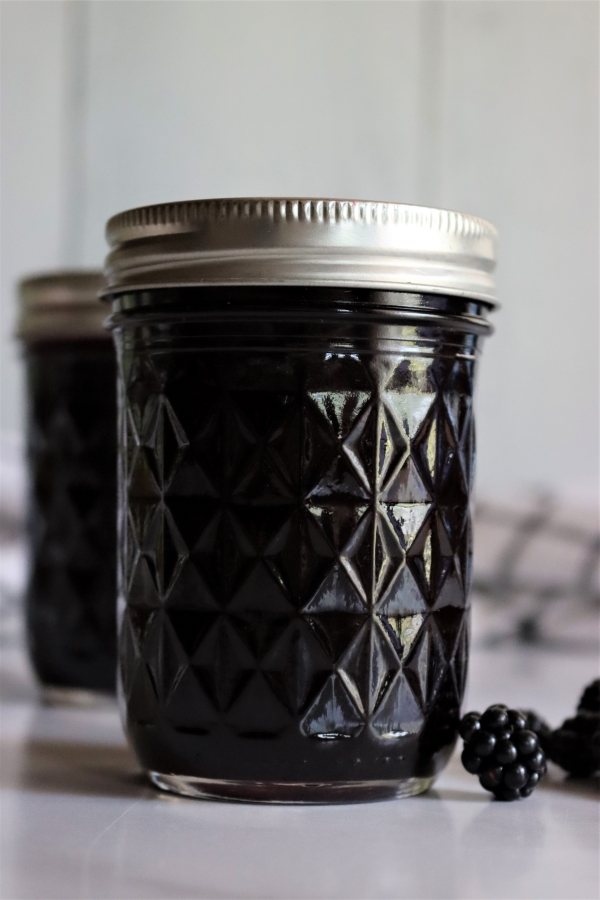
Ways to Preserve Blackberries
Looking for a few more ways to preserve blackberries?
- Blackberry Fruit Leather
- Canning Whole Blackberries
- Blackberry Fruit Butter
- Freezing Blackberries
- Dehydrating Blackberries
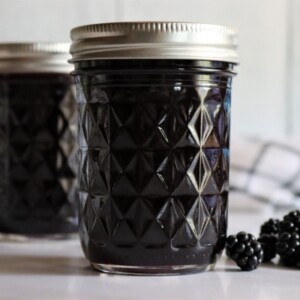
Blackberry Jelly Recipe without Pectin
Ingredients
- 4 cups blackberry juice, from 9 cups or 2 1/2 quarts berries & 1 cup water
- 3 cups sugar
Instructions
Making Blackberry Juice
- Place 9 cups fresh blackberries into a heavy-bottomed pot with 1 cup of water.
- Bring the mixture to a boil over medium-high heat, mashing as the mixture cooks.
- After about 5 minutes, the blackberries should have completely fallen apart and released their juices. Remove the mixture from heat.
- Pour the blackberry pulp through a jelly bag, or a cheesecloth-lined strainer. Allow the mixture to drain for at least an hour until it stops dripping and the pulp is pretty dry.
- Measure the collected juice, you should have about 4 cups. (Other yields will work fine too, see notes.)
Making Blackberry Jelly
- For every cup of blackberry juice, add 3/4 cup of cane sugar.
- Place the sugar/juice mixture into a deep jam pot and bring to a boil over high heat.
- After about 5-8 minutes, the mixture should reach gel stage. Test for gel stage on a plate that’s been placed in the freezer, or with an instant-read thermometer (220 degrees F at sea level, see notes for other elevations).
- Pour the mixture into prepared jam jars, leaving 1/4 inch headspace.
- Seal with 2 part lids.
- Store in the refrigerator for immediate use, or freezer for up to 6 months. For longer-term storage, canning is a better option.
Canning Blackberry Jelly
- Prepare a water bath canner before you begin making the jelly (while the juice is straining).
- Fill jars the hot jelly mixture, leaving 1/4 inch headspace, and seal with 2 part lids.
- Process in a water bath canner for 10 minutes.
- Remove the jars to cool on a towel on the counter. After 24 hours, check seals and store any unsealed jars in the refrigerator for immediate use.
- Properly canned and sealed jars of homemade blackberry jelly will maintain quality for 12-18 months at room temperature in the pantry.
Notes
Easy Homemade Jellies
Looking for more easy homemade jellies?
Summer Canning Recipes
Putting up more than just blackberries this season? I have more than 100 canning recipes for you…
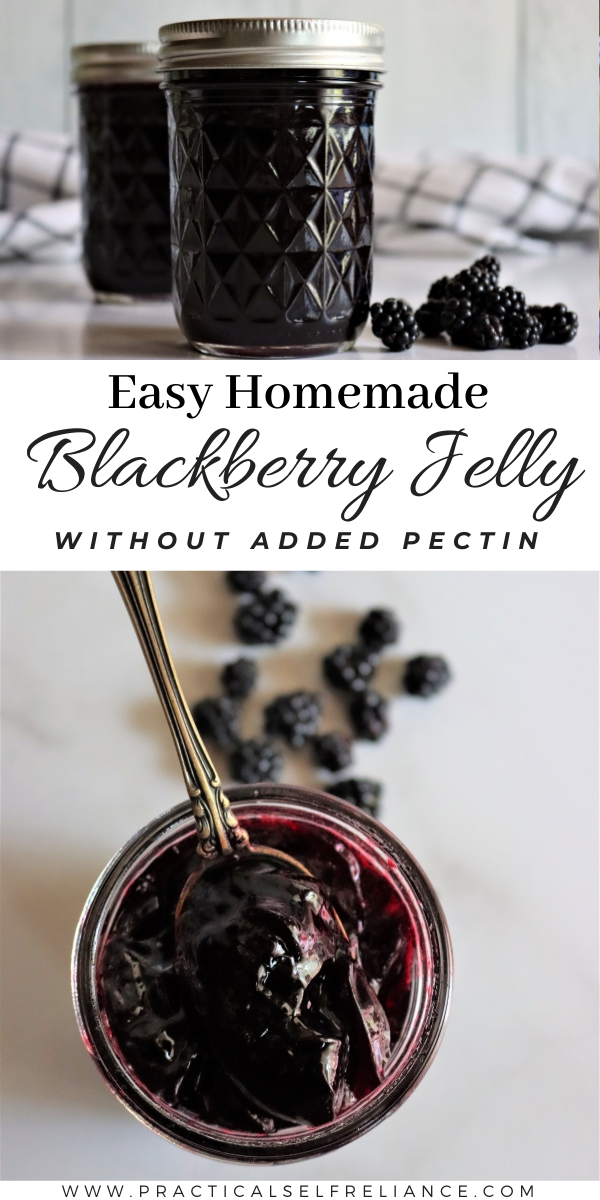
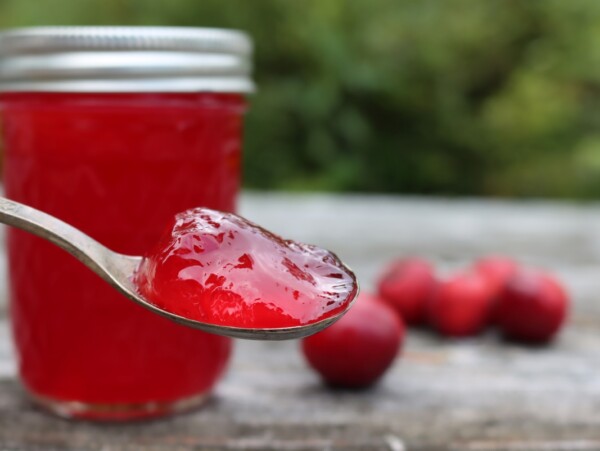
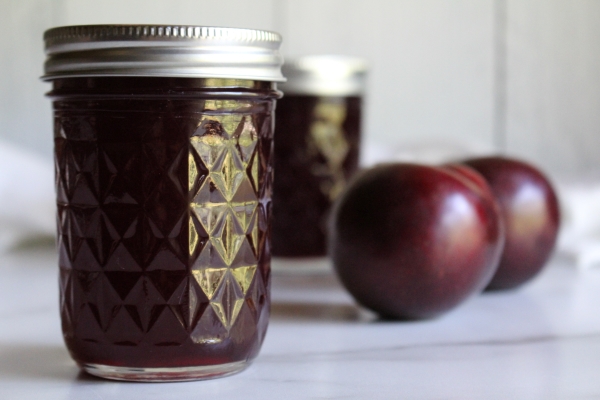
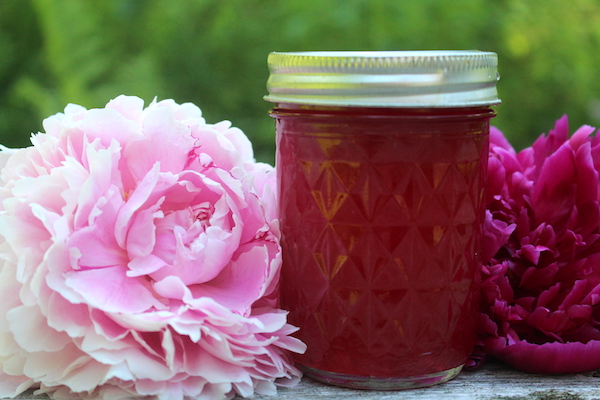
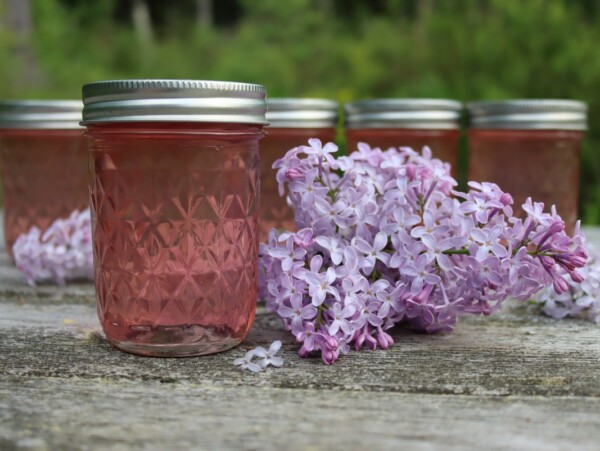
Hi Ashley! I’m excited to try this recipe for jelly without the seeds. Can it be doubled without any setting issues as long as my pot is big enough?
We usually do not recommend doubling jam or jelly recipes since it can affect the way that the product sets.
I made this blackberry Jelly from frozen black berries. I am so happy to say that this recipe turned out delish!! I just want ask about the lemon juice?? Do you make it with lemon juice now and how much would you use?
You can add a tablespoon or two of lemon juice if you want a more tart flavor.
Is there a recipe somewhere in this story????
The recipe cards can be found at the bottom of each blog post.